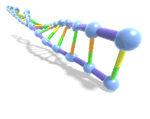
Slave traders in Senegal. “Marchands d’esclaves de Gorée-Jacques Grasset de Saint-Sauveur mg 8526” by Rama – Own work. Licensed under Public Domain via Wikimedia Commons. Click to see image online.
Did you hear what has been discovered about the remains of three Caribbean slaves found on the island of St. Martin? Scientific techniques identified them as two males and one female, all between 25 and 40 years of age, who were buried around the mid-to-late-1600s.
But where were they from? It took DNA to help answer that question, with a process very similar to that used to identify our ethnic origins in DNA testing today.
First, scientists had to retrieve DNA from the sun-bleached, humidity-soaked remains. Their first stop: the teeth. Traditional DNA extraction and analysis methods failed, but results were found with a new method called whole genome capture. You can think of this method like unleashing an army of vigilantes on your DNA, each one tasked with bringing back a particular portion for analysis. While this method was far more successful, it still was only able to find 7% of the DNA of the best sample.
Second, they needed a reference population: a group of Africans to compare these results to in order to find a match. There is such a group assembled, which contains 11 of the likely 50 population groups that contributed to the slave trade. Keep in mind that in Africa, especially at that time, populations were not defined by geography as much as language. So when you hear African populations defined, it is often according to their relationship to one very large language group in Africa, called Bantu. There are really two groups: those that are Bantu speakers, and those who are not.
Even with the incomplete DNA and the limited reference population, the group was able to determine that two of the slaves belonged to non-Bantu speaking tribes, likely in present day Ghana or Nigera, while the third was Bantu speaking, possibly from northern Cameroon.
Finding ancient samples such as these, and having technology enough to analyze them, if even just a small part, has huge implications for the future of genetic genealogy, and family history. These kinds of genetic techniques can help place you in a genealogical relationship with another person, where your traditional genealogical methods could not. Family history, the substance and story of your relationship, inevitably follows.
I think Fatimah Jackson, a biologist and anthropologist at Howard University, said it best. “It seems to me that, as a scientist, the best way to ‘honor’ these unfortunate individuals is to allow their story to be told,” she says. “The story of a few can illuminate the condition of the masses.” We may never know the names and specific life histories of this woman and two men any more than we already do. But DNA has gotten us closer to telling at least some of their story. Click here to read the scientific study.
 Are you ready to let your genetics help tell your story? Learn more about DNA testing with my Getting Started in Genetic Genealogy Quick Guide, available now in the Genealogy Gems store. In fact, I have a whole series of Guides there on using DNA for genealogy. Check them all out!
Are you ready to let your genetics help tell your story? Learn more about DNA testing with my Getting Started in Genetic Genealogy Quick Guide, available now in the Genealogy Gems store. In fact, I have a whole series of Guides there on using DNA for genealogy. Check them all out!
If you’re ready for some one-on-one consulting to see what DNA can tell you about your family history, visit my website to learn more.




